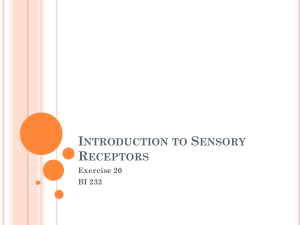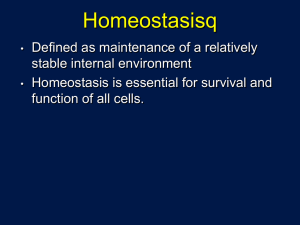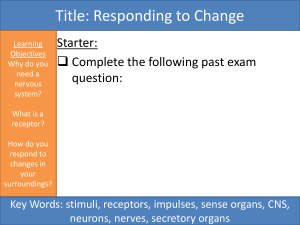MOA slides - Epilepsy treatment
advertisement
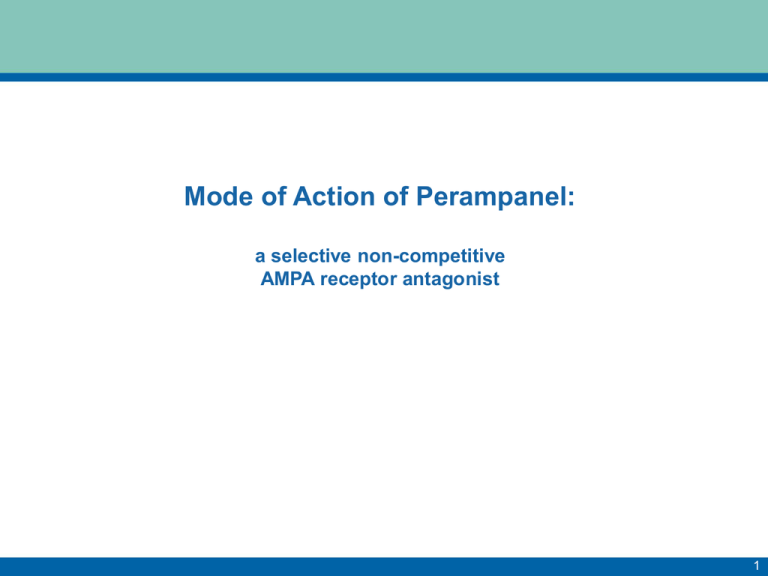
Mode of Action of Perampanel: a selective non-competitive AMPA receptor antagonist Information prepared by Eisai Europe Ltd 1 Contents • Mode of Action (MOA) of existing anti-epileptic drugs (AEDs) • Glutamate mediated Post Synaptic Excitation • MOA of Perampanel, a selective, non-competitive AMPA receptor antagonist • AMPA: α-amino-3-hydroxy-5-methyl-4-isoxazole-proprionic acid 2 Understanding key transmitter systems is important in understanding seizures and AED actions • The CNS uses a large number of ion channels, neurotransmitters, and receptors to communicate • Several of these systems are important in understanding epilepsy – The biological mechanisms underlying seizure activity – The mechanism of action of antiepileptic drugs (AEDs) • The following slides provide information on some of these key ion channels and neurotransmitter systems, arranged in 3 conceptual groups: 1. Pre-synaptic excitability and transmitter release 2. GABA inhibitory systems 3. Post-synaptic glutamate receptors 3 Understanding key transmitter systems is important in understanding seizures and AED actions • The CNS uses a large number of ion channels, neurotransmitters, and receptors to communicate • Several of these systems are important in understanding epilepsy – The biological mechanisms underlying seizure activity – The mechanism of action of antiepileptic drugs (AEDs) • The following slides provide information on some of these key ion channels and neurotransmitter systems, arranged in 3 conceptual groups: 1. Pre-synaptic excitability and transmitter release 2. GABA inhibitory systems 3. Post-synaptic glutamate receptors 4 1. Pre-synaptic excitability and neurotransmitter release 1. Pre-synaptic excitability and transmitter release Pre-synaptic neuron Voltage-gated Na+ channel Voltage-gated K+ channel Voltage-gated Ca2+ channel Inhibitory interneuron Redrawn and adapted from: Rogawski MA, Löscher W. Nat Rev Neurosci 2004;5:553–564; Rogawski MA. Epilepsy Currents 2011;11:56–63. Post-synaptic neuron 5 2. GABA inhibitory systems 2. GABA inhibitory systems Pre-synaptic neuron GABAA receptor GABA transaminase GABA transporter Inhibitory interneuron Redrawn and adapted from : Rogawski MA, Löscher W. Nat Rev Neurosci 2004;5:553–564; Rogawski MA. Epilepsy Currents 2011;11:56–63. Post-synaptic neuron 6 3. Post-synaptic excitability 3. Post-synaptic excitability Pre-synaptic neuron Not targeted selectively by any approved AEDs prior to perampanel Felbamate has weak affinity for NMDA receptors and topiramate binds both AMPA and kainate receptors... ...but the primary MOA of these AEDs is inhibition of voltage-gated Na+ channels AMPA receptor Glutamate NMDA receptor Inhibitory interneuron Redrawn and adapted from: Rogawski MA, Löscher W. Nat Rev Neurosci 2004;5:553–564; Rogawski MA. Epilepsy Currents 2011;11:56–63. Post-synaptic neuron 7 Glutamate mediated Post-synaptic excitability 8 Glutamate mediates most fast excitatory neurotransmission in the CNS • Glutamate is the principal excitatory neurotransmitter in the CNS1 – Effects mediated via ionotropic receptors (ion channels) and metabotropic receptors1,2 • Ionotropic receptors mediate glutamate’s fast excitatory neurotransmission at synapses2,3 – Three types, all activated by glutamate but named after the synthetic agonists used to characterise the receptors: AMPA: -amino-3-hydroxy-5-methyl-4-isoxazolepropionic acid NMDA: N-methyl-D-aspartate Kainate: Kainic acid AMPA receptor Kainate receptor NMDA receptor 1Rogawski MA. Epilepsy Currents 2011;11:56–63; 2Meldrum BS. J Nutr 2000;130:1007S–1015S; 3Meldrum BS, Rogawski MA. Neurotherapeutics 2007;4:18–61. 9 AMPA receptors mediate glutamate fast signalling • AMPA receptors are the most abundant ionotropic glutamate receptors in the mammalian brain • They are localised at excitatory synapses, post-synaptically • AMPA receptors mediate the fast response to glutamate – Generate the fast component of the excitatory post synaptic potential (EPSP) – If sufficient EPSPs result, these summate and result in firing of an action potential Action potentials EPSP Rogawski MA. Epilepsy Currents; 2011;11:56–63. 10 Glutamate mediates most fast excitatory neurotransmission in the CNS • AMPA is the main receptor mediating rapid effects of glutamate1 – Underlies fast component of EPSP1,2 • NMDA receptor does not normally contribute to fast neurotransmission1,2 – Underlies slow component of the EPSP1,2 – Involved in plasticity e.g. learning and memory1,3 EPSP Fast Slow 1Rogawski MA. Epilepsy Currents; 2011;11:56–63; 2Meldrum BS. J Nutr 2000;130:1007S–1015S; 3Meldrum BS, Rogawski MA. Neurotherapeutics 2007;4:18–61. 11 AMPA receptors may trigger seizure activity via the PDS (Paroxysmal Depolarising Shift) • AMPA receptors drive EPSPs at individual synapses and across networks • Synchronised EPSPs across neuronal networks are thought to drive the PDS1,2 • The AMPA receptor is thought to mediate the initial component of the PDS Initial component mediated by AMPA receptors EPSP PDS Later component mediated by NMDA receptors 1Acharya JN. Curr Sci 2002;82:679–688; 2Chapman AG. J Nutr 2000;130:1043S–1045S. 12 Neuronal hyperexcitability results, somehow, in seizures • Individual neurons within an area may be hyperexcitable1 • These neurons occasionally have sudden (paroxysmal), synchronous depolarisations, and fire bursts of action potential bursts1 – Paroxysmal depolarisation shift (PDS)2 PDS 1Dichter MA. In: Epilepsy. A comprehensive textbook. 2008; 2Rang HP et al. In: Pharmacology. 1995. 13 Glutamate and the AMPA receptor play an important role in seizure activity • Glutamate and the AMPA receptor are important in seizure activity1–4 • Glutamate is implicated in acute and chronic neurodegeneration • How do we know glutamate is important in seizures? – Glutamate levels increase before and during seizures in humans1 • Suggests that elevated glutamate levels can trigger and maintain seizures – AMPA receptor agonists initiate seizures in animal models3 – AMPA receptor antagonists have anti-seizure activity in animal models3 • Suggests AMPA receptors are involved in seizure initiation and spread2–4 • How are AMPA receptors involved in seizures? – AMPA receptors are known to drive EPSPs at excitatory synapses (normal neuronal activity) – It is thought that AMPA receptors are involved in the PDS (Paroxysmal Depolarising Shift)5,6 1During MJ, Spencer DD. Lancet 1993;341:1607–1610; 2Meldrum BS, Rogawski MA. Neurotherapeutics 2007;4:18–61; 3Meldrum BS. J Nutr 2000;130:1007S–1015S; 4Rogawski MA, Donevan SD. Adv Neurol 1999;79:947–63; 5Acharya JN. Curr Sci 2002;82:679–688; 6Chapman AG. J Nutr 2000;130:1043S–1045S. 14 AMPA receptor structure AMPA receptor (closed, inactive state) AMPA receptor (open, active state) Glutamate-binding sites (also ligand-binding sites or domains) Na+ ions Glutamate Non-competitive binding sites 1Wilcox KS et al. In: Epilepsy: a comprehensive textbook. 2008; JD et al. J Neurosci 1998;18:119–121. 2Clements The receptor’s ion channel allows influx of Na+ ions (and sometimes Ca2+ ions) into the neuron 15 Glutamate opens the AMPA receptor to allow Na+ influx Normal situation 1. Glutamate binds and activates the receptor 2. Na+ enters through the open channel 3. Channel returns to closed state when glutamate dissociates Na+ ions Glutamate Wilcox KS et al. In: Epilepsy: a comprehensive textbook. 2008. 16 Competitive antagonists may be displaced by high levels of glutamate In the presence of a competitive antagonist 1. Glutamate cannot bind so cannot activate the receptor BUT when glutamate levels are high... 2. Glutamate displaces the antagonist... 3. ...binds to the receptor and activates it, opening the channel and allowing Na+ influx Na+ ions Glutamate Rang HP et al. In: Pharmacology. 1995. Competitive antagonist 17 Non-competitive antagonists should maintain activity even when glutamate levels are high In the presence of perampanel1 1. Glutamate binds but cannot activate the receptor1 AND when glutamate levels are high... 2. ...non-competitive antagonist is not displaced by glutamate2 3. Receptor antagonism is maintained and the channel remains closed Na+ ions Glutamate 1Hanada T et al. Epilepsia 2011;52:1331–1340; 2Kenakin T. Molecular Interventions 2004;4:222–229. Perampanel 18 AMPA receptor antagonism and seizure activity AMPA receptors: • Important role in seizure initiation and spread • Important and promising target for epilepsy therapy AMPA receptor antagonists: • Anti-seizure activity in a broad range of animal models Perampanel: • A non-competitive AMPA receptor antagonist • Studied in Phase III clinical trials in patients with refractory partial-onset seizures Rogawski MA. Epilepsy Currents 2011;11:56–63. 19 Perampanel is selective for AMPA receptors In ligand-binding studies1,2 • Perampanel has minimal affinity for receptors other than the AMPA receptor In receptor function studies1 • Perampanel inhibits function of AMPA receptors at concentrations that have no effect on NMDA receptor function Effect on AMPA receptor function 50% inhibition at 93 nMa a300-times 1Hanada Effect on NMDA receptor function 18% inhibition at 30 μMa higher concentration required to achieve a smaller inhibitory effect T et al. Epilepsia 2011;52(7):1331–1340; 2Tokuhara N et al. Poster presented at AAN 2008. 20 Perampanel is a non-competitive antagonist Radiolabelled binding studies demonstrate perampanel binds at a noncompetitive site • In these studies, perampanel was radioactively labelled, and its binding to neuronal membranes in vitro was measured • Radiolabelled perampanel binds with high affinity – • Adding AMPA or glutamate does not reduce binding of radio-labelled perampanel – • This shows that perampanel binds to a specific target site in the brain This shows that perampanel does NOT bind to the glutamate-binding site of the AMPA receptor; if it did, glutamate and AMPA would displace its binding Adding known non-competitive AMPA receptor antagonists does reduce binding of radio-labelled perampanel – This shows that perampanel DOES bind to a non-competitive site Hanada T et al. Epilepsia 2011;52(7):1331–1340. 21 Perampanel is a selective, non-competitive, AMPA receptor antagonist What does this mean? Explanation1–3 AMPA receptor antagonist1 • Reduces the ability of glutamate (or any other AMPA receptor agonist) to activate the AMPA receptor • Selectively binds to AMPA receptors Selective1 • Doesn’t have significant affinity for other glutamate receptors or other receptors or transporters • Binds to the AMPA receptor at a non-competitive site Non-competitive1 – Does not DIRECTLY block glutamate from binding to the receptor at the glutamate-binding site – Does INDIRECTLY (or non-competitively) inhibit the ability of glutamate to activate the receptor, by binding to the AMPA receptor at a non-competitive site 1Hanada T et al. Epilepsia 2011;52(7):1331–1340; 2Rang HP et al. In: Pharmacology. 1995; 3Kenakin T. Molecular Interventions 2004;4:222–229. 22 Perampanel is a selective, non-competitive, AMPA receptor antagonist What are the theoretical implications? Implications1–4 AMPA receptor antagonist1 Selective1 • Reduces activation of AMPA receptors by glutamate, reducing excitability of neurons expressing these receptors • Perampanel is unlikely to have effects on non-AMPA glutamate receptors – low potential for phencyclidine-likea effects as no significant NMDA receptor binding • Unlikely to have effects on other receptors or transporters • Activity of a non-competitive antagonist is maintained even when levels of the agonist (e.g. glutamate) are high Non-competitive1 • In contrast, a competitive antagonist is displaced (outcompeted) when agonist concentrations are high, allowing glutamate to bind and activate the receptor also known as ‘angel dust’ or PCP T et al. Epilepsia 2011;52(7):1331–1340; 2Rogawski MA. Epilepsy Currents 2011;11:56–63; 3Kenakin T. In: A Pharmacology Primer. 2006; 4Rang HP et al. In: Pharmacology. 1995. aPhencyclidine 1Hanada 23
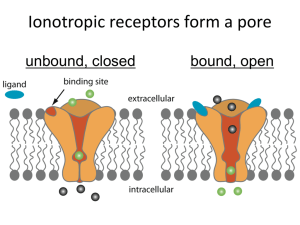
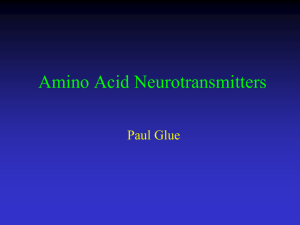
![Shark Electrosense: physiology and circuit model []](http://s2.studylib.net/store/data/005306781_1-34d5e86294a52e9275a69716495e2e51-300x300.png)



